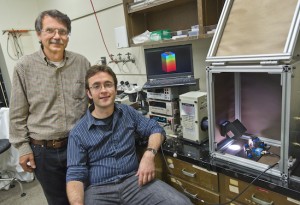LBL researchers discover novel way to make PV out of any semiconducting material
 It’s a new way to think about photovoltaic materials that could lead to less-costly PV. Instead of doping silicon or other materials with semiconductors to create a PV cell, the method, called screening-engineered field-effect photovoltaics (SFPV) relies on the electric field effect. This allows a wider range, and likely a less expensive range of materials to be considered for photovoltaics. The research was conducted at the Lawrence Berkeley National Laboratory (LBL) and the University of California Berkeley.
It’s a new way to think about photovoltaic materials that could lead to less-costly PV. Instead of doping silicon or other materials with semiconductors to create a PV cell, the method, called screening-engineered field-effect photovoltaics (SFPV) relies on the electric field effect. This allows a wider range, and likely a less expensive range of materials to be considered for photovoltaics. The research was conducted at the Lawrence Berkeley National Laboratory (LBL) and the University of California Berkeley.
“Our process can be done to any semiconductors,” said Will Regan, one of the researchers who cowrote the research paper, “Screening-Engineered Field-Effect Solar Cells,” in Nano Letters. Regan worked with, Alex Zettl and Feng Wang who led the research and co-wrote the paper with Steven Byrnes, Will Gannett, Onur Ergen and Oscar Vazquez-Mena.
However, there are certain design considerations for certain semiconductors and some semiconductors are better suited than others for such an application. “We want to use the ones that are most optimized and apply our process to [those],” Regan said. “The reason it would work for anything is because it’s very fundamental. We’re applying an electric field when you do that charges will move around inside the semiconductor.”
Doping doesn’t work for certain materials because the crystal can get damaged, or materials within the device can move around resulting in a device that isn’t stable. Since the process requires applying an electric field to a semiconductor, rather than chemically doping it, it allows a greater range of materials to be used. But the material also has to be tailored to make an electrical contact. “If you put a metal on a field the electric can’t pass through but by tailoring the electric it field can pass through it,” Regan said.
“All we’re doing is taking a traditional solar cell and making it better with this,” Regan said. The goal is to make more efficient, lower-cost PV. And at this point you can produce high cost, high efficiency PV or low-cost, low-efficient PV. “We can use this technology with low-cost, materials, but can make them better with field tuning,” he said.
“We’re exploring a lot of commercial sides of it right now, too. We’re looking at other materials,” Regan said. In the research paper, the team looked at silicon-PV in the paper, but also showed the potential for copper oxide. However, they’re also looking at other materials, including CIGS and CadTel.



